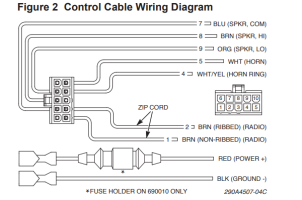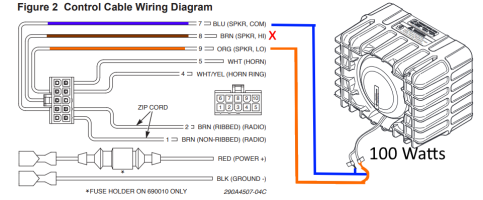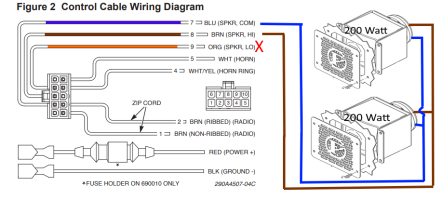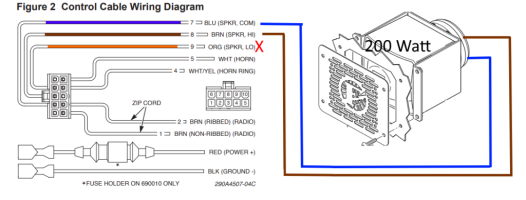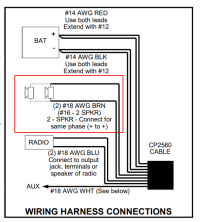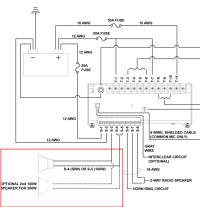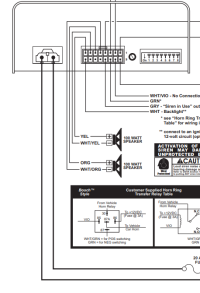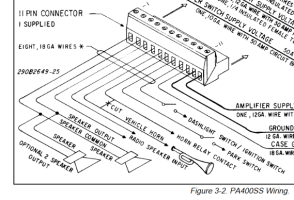You are right John. It seems to me that they have hired a 6yo to write up the manual.
With this, I’m starting to think that the 200watt versions of the pa300 aren’t really “true” 200watts. This makes me want to stick with just Whelen or Carson.
Here is where things clicked for me.... Get ready for a wall of text built by years of frustration;
I started thinking about my crusade against the PA300 at my two old jobs (ambulance maintenance). I was "Capt. Marcson, Remover of all things PA300 and Installer of all Things Whelen" to the point it became a joke. For some reason the region I work(ed) in love(d) PA300s and many ambulances and fire apparatus had them as a 200w primary siren. Also, they were a PITA to replace. I would end up with a 100W version having been installed as a replacement prior to me working on it or a replacement being ordered and showing up as the 100w version. If you just order a PA300 it's 100w. The 200w version is a special order, not a "hop on Galls real quick" purchase.
I used to complain to a guy with the same job at a nearby town/county that ran PA300s and Qs. I do love the sound of a Q overtop a
100w PA300; but there were rouge units with a Q and a 200w PA300 or just a PA300. He serviced PD stuff as well and somehow the PA300s bled over there. At the PD "the watts were made up and the speakers didn't matter". I remember calling him after I worked on 2 "identical" ambulances with sequential build numbers with completely different wiring on the sirens (PA300s). He told me to get used to it, and that he just pulled a 100w PA 300 running dual 100w speakers that was only woking because it was hooked up wrong and one speaker was essentially not connected.
After researching my answers for this thread I starting piecing this cluster together more; opening old wounds for the sake of full closure. I got a little more info from this I person mentioned too. Our going theory is that most sirens are designed to be 200w or 100w. The 200w versions of sirens are made to adjust to accommodate the removal (or non-installation) of one of the 100w speakers and run as a single speaker 100w siren. The 100w versions of sirens are just that, a 100w siren. The PA300, and all other PA siren versions until PA400, were that kind of true 100w siren. To accommodate 200w in the PA300 the power was stepped up in an "add on" way and a second "double watt" output added, the original design left unaltered. You really have a 100w siren with a "booster pack" output. If it were truly updated you would just have a single set of outputs or two identical ones and the option to hook up one or two speakers (like every other 200w siren). The presence of a single "high" and "low" output that must "never be used together" is very telling. The 200w PA300 shouldn't be a thing. Even an aux amp option like the older Whelen 295HFS2 would have been better. Leave the PA300 100w and allow an add on amp for 200w applications.
So, now to my saga of fighting the "200w" PA300 in real life. When you are running 200w via dual 100w speakers and one of your speakers blows on most sirens it is not a big deal. You lose 100w, On a PA300 you lose a speaker now your lone speaker is running as a 100w speaker on the "high" output. The manual says not to run a 100w speaker on the high output. Guess what happens? It blows too, and/or sometimes the siren overheats and blows the fuse (if you are lucky). Amongst the ambulances that had PA300s I worked on, every one had at least one heat damage incident usually a glass fuse holder melting or discoloration appearing with a fuse blowing, and they were the only model sirens where they would 100% fail due to needing BOTH speakers replaced. With the Carsons and Whelens the crews would notice and report a speaker out. They noticed either by volume, LED indicator, or lack of dual tone, and the work order would say as much. With Carson I'd get "Siren is quiet" and with Whelen I'd get "one red light on the siren is out" or "It's single tone only". I'd bring them in to my main building and slide under and (once I wised up) do both speakers as a preventive maintenance while I was under there. Maybe 75% of the time it was visibly time to replace both speakers due to salt damage anyway, which was initially the policy (replace only if indicated). I eventually realized that if I just did both every time I saved a world of problems, downtime, and work.
Before I started doing a 100% speaker replacement (and replaced just the failed speaker as instructed by the budget watchers) you were feeding 200w to a brand new speaker and an older speaker. The older speaker would fail within a few shifts and you were back to a single speaker again, which then caused the other failure. No wonder we had two (three including a combo of both) basic PA300 failures; both being 100% "no sound" failures. I'd see trucks with heat damaged sirens/wiring and blown fuses with one bad speaker or trucks with two bad speakers, or maybe a combo of both problems (two bad speakers and heat issues). If both speakers were getting older, they both just failed one right after the other, and you had no sound, but a working siren without damage to the unit. In the days of only replacing one speaker, the "not new" other speaker just failed and we are back to having 200w shoved at one brand new speaker, that's more when I saw fuse/heat failures. I was seeing the outcomes of pushing 200w at a single 100w speaker and the variable was the condition of that single speaker. If one speaker was new I got damage to the siren wiring, if the speakers were both older, the speakers both died in order of condition. That's why my policy to never replace just one speaker ended up solving the a lot of the issues. In the end me becoming the "St. Patrick of Sirens" on the PA300 was the real fix, and having driven them from my island I was happy.
Thanks so much for posting this thread. it brought back painful memories, but it gave me some closure by exposing the etiology behind the "PA300 phenomenon".




